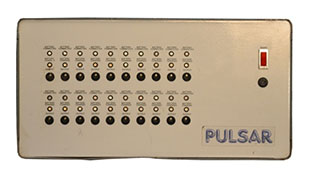Pulsar




Founded By: Bernard Faiers
Originated: May 4, 1993 Date Closed: 1995
Number of Locations: Unknown
Personnel of Note:
Tony Taylor- Company Director
Bernard Faiers – Company Director
Janette Faiers – Company Secretary
Will Latham – Chief Engineer
Martin Shoebridge – Technical Contributor
First Facility: Unknown
Equipment Overview: Pulsar equipment first debuted during a Leisure Industry week exhibition held in September of 1993. One of the most notable features was the pack’s ability to confirm a tag had hit by announcing “good shot” when an opponent’s pack was tagged. Sensors and the pack could detect a hit and the informational letter and would be stored until the end of the game when the information would be downloaded into a computer.
Three versions of Pulsar equipment were created. Version 1 launched in 1993 and had no shoulder sensors, but did include a chest plate, back plate and phaser. LED lights in the chest plate formed a V pattern. Version 2 came out in 1984 and looked remarkably similar to version 1 only the chest board included three circles in a design reminiscent of Mickey Mouse in place of the V shape LED pattern featured in the previous version. Version 3 debuted in 1995 and included shoulder sensors. To quote from a Pulsar prospectus from 1995, “We are pleased to announce for the first time our RANK STARS which are built into each epaulette. The six stars illuminate as the player progressively eliminates their opponent. These Rank Stars allow the other players to visually recognize their predator’s bonus life status and can then take evasive action, if necessary until their own rank has built to an equal status.” A shoulder sensor harness is a built-in feature on the front, back and sides of the shoulder sensors. The equipment also included a phaser.
Historical Synopsis: A relationship between Pulsar International Ltd was formed with Space Race in 1993 in order to use their laser tag gear inside an arena featuring Doctor Who theming. Momentum Ltd. was commissioned by Pulsar on February 9, 1993 for the development of their laser tag system.
Principles involved in both Space Race and Laser Force UK included David Byrne and Steve Felson. There were some shared features between Pulsar and Laser Force UK, though the latter company was winding down at the time that Pulsar was first launching into the laser tag market. Pulsar’s chief engineer William Latham later created the Solaris Leisure system and Momentum Ltd later developed Hanger 51.
